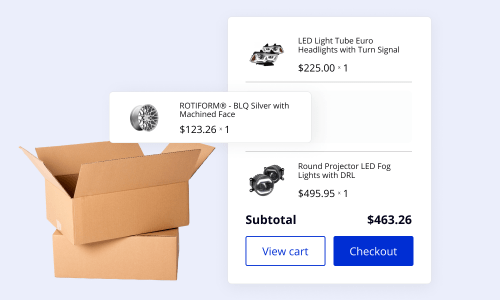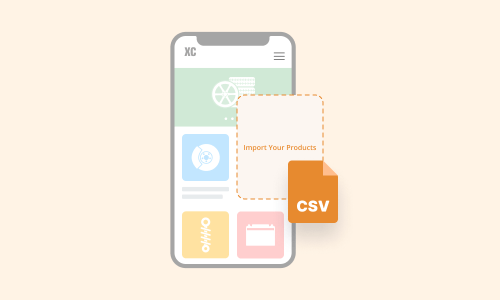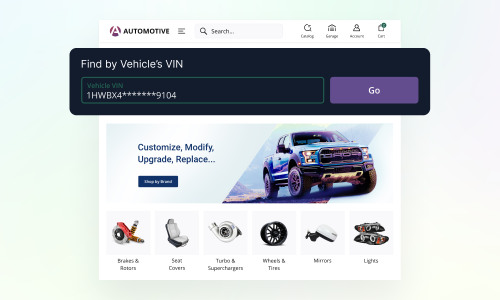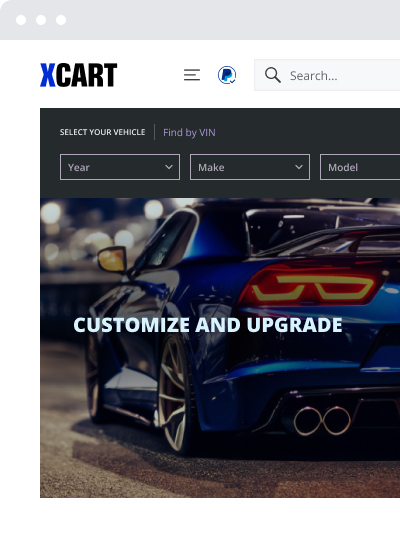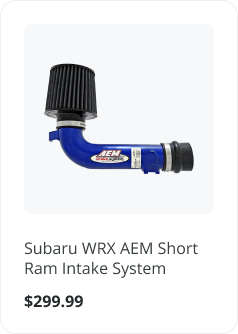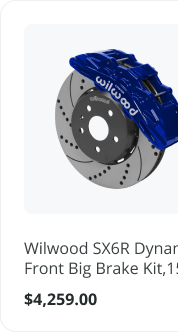Testing the Waters of Auto Parts eCommerce? From Offline to Online Retail in 5 Simple Steps

Let’s face it: eCommerce is now a deeply-ingrained shopping solution for consumers across many industries, and the automotive aftermarket retail is no exception.
Today, about nine out of ten shoppers do online research before purchasing an auto part or accessory, whether they eventually buy from a brick-and-mortar store or make an order online. As consumers become increasingly comfortable browsing and buying automotive parts online, physical store owners have to pay more attention to digital sales channels.
As a result, the automotive aftermarket e-retail market is growing at an accelerating pace. According to Business Research Insights, the global automotive parts e-retailing market was estimated at $64.48 billion in 2022 and is expected to reach $169.70 billion in 2028 with North America, representing 36% of the market’s growth.
We are here to help you plan your digital expansion and adjust your current business model to the new normal in five easy-to-follow steps:
- Conduct automotive eCommerce market research.
- Identify the Online Demand and your target audience.
- Consider the specifics of running an online business.
- Choose an eCommerce platform.
- Map your marketing strategies to build a solid online presence.
Let us fill you in one step at a time.
1. First Things First: Investigate the Market
Whether you plan to sell car parts on Amazon or eBay, build your own online store, or successfully combine these options, you should fully understand the e-retail aftermarket landscape. This will help you assess your business’s strengths and weaknesses and develop an actionable insight-driven plan before you dip your toes in the eCommerce waters.

Identify the Online Demand
Knowing which auto parts best sell online is essential for staying on top of a highly competitive eCommerce market.
As a rule of thumb, car parts that wear and tear quickly have a higher turnover. So, it’s only logical that car tires sit comfortably in the top ten best-selling products on eBay and Amazon. Exterior parts, interior parts, and lighting and LED products also make the three top-selling categories on Amazon.com.
Consider your profit margin while determining which car parts categories you’d like to offer online. For example, selling batteries or heavy, complex items that are part of the powertrain can be challenging, mainly because this always results in higher shipping costs. In contrast, accessory products and chemicals such as oils, additives, wax, and other auto consumables are always in high demand and much easier to deliver.
Selling auto parts and accessories online also means staying updated on trending topics in the industry. According to Linchpinseo, modular systems designed for overlanding, camping, and off-roading are steadily growing in the aftermarket world. In addition, hybrid and electric vehicle components are also expected to attract more customers in 2023.
Summing up: Investigate the car parts specialty areas to identify auto parts categories with high online penetration. In addition, you can carry out a thorough competitor analysis and do the research of automotive marketplaces to find a low-competition yet high-demand niche.
2. Define Your Online Target Audience
Just like you’ve built your offline business around your customer pool, define your online target audience by determining their age, gender, and geographic locations. But more than demographic data, you’ll need to look at their lifestyle, pain points, and expectations that you can fulfill. The data you need to know also depends on whether you have a B2B or B2C business.
It’s not uncommon for businesses to be wrong with their first assumptions regarding their online buyer personas. Do surveys and talk to your customers to adjust your business model once you learn more about your target audience.
3. Know the Specifics of Running an eCommerce Business
Even if you have years of experience in an offline business, you should be aware of some specifics of running an online store. Thus, during your planning phase, it is crucial to iron out such details as online sales taxes, data synchronization, and delivery methods, to name a few.
Determine Your Sales Tax Nexus
Today, eCommerce businesses should track and pay sales tax in every state where they meet the threshold for economic nexus. Given that each state has its own set of rules for sales tax, business owners who sell online across the U.S. need to stay compliant with the tax laws in over 12,000 jurisdictions.
Knowing the specific tax laws for each state where you plan to sell online is crucial, as it will help your business avoid audits, fines, and repayments.
Map Your Order Fulfillment Strategy
Shipping automotive parts can be notoriously tricky due to product sizes and weights. You have several options to organize auto parts delivery for your online customers:
| Dropshipping | With the dropshipping business model, sellers don’t have to worry about packing up products, finding a courier, or deciding what type of shipping their products need. After the online purchase, all the order details are sent to the supplier, who packs and ships the product directly to the customer. | With the dropshipping business model, sellers don’t have to worry about packing up products, finding a courier, or deciding what type of shipping their products need. After the online purchase, all the order details are sent to the supplier, who packs and ships the product directly to the customer. | |
| In-house fulfillment | Self-fulfillment includes receiving merchandise, storing inventory, processing orders, packing them for shipment, and sending them to the customer. | Self-fulfillment includes receiving merchandise, storing inventory, processing orders, packing them for shipment, and sending them to the customer. | |
| Third-party fulfillment | With third-party fulfillment, sellers outsource the order processing, inventory storage, and shipping operations (partially or all) to a third-party provider. An excellent example of outsourced fulfillment is Amazon FBA (fulfillment by Amazon). | With third-party fulfillment, sellers outsource the order processing, inventory storage, and shipping operations (partially or all) to a third-party provider. An excellent example of outsourced fulfillment is Amazon FBA (fulfillment by Amazon). | |
| In-store pickup | As the name suggests, the Buy Online Pick up In-Store shipping option enables customers to order online but get their items in the nearest offline store. | As the name suggests, the Buy Online Pick up In-Store shipping option enables customers to order online but get their items in the nearest offline store. | |
Your choice of the shipping methods will mainly depend on your business model and the auto parts categories you’ll decide to sell.
Assess the Importance of Data Synchronization
Data accuracy, privacy, and consistency are the three whales of a successful online business. Even a minor error can hurt sales, result in poor decision-making, and decrease customer loyalty.
This is where data synchronization can make a big difference. Syncing all your business data into a single database will help you avoid order processing mistakes, prevent privacy breaches, and ensure your sales and marketing teams are under one umbrella.
4. Select an eCommerce Platform
To be in the game among the auto parts winners, you should select an industry-specific shopping cart solution that can seamlessly adjust to your business needs, painlessly pivot to the new initiatives, and grow together with your sales. In other words, you’ll need an eCommerce platform that combines out-of-the-box functionality with the high-level customization options and is designed specifically for automotive businesses.
What you can expect from an eCommerce solution designed specifically for the Automotive Aftermarket:
- Hassle-free auto parts catalog management that aligns with the Aftermarket Catalog Exchange Standard (ACES) and Product Information Exchange Standard (PIES).
- Organizing and handling large product catalogs with thousands of SKUs, complex category structure, and numerous product variations.
- High-performance car parts search, ensured by the year/make/model and VIN lookup functionality for better customer experiences.
- Automated and streamlined order processing powered by multiple integrations with inventory management systems and shipping software systems.
- Mobile-first website design that ensures a personalized and consistent online shopping experience.
- Broad website promotion opportunities allowing for SEO optimization, PPC advertising, social media and email marketing.
- Online and in-store experiences merged seamlessly within a single offline-to-online (O2O) strategy.
- Professional assistance while maintaining your auto parts eСommerce website.
Running an online business means having a lot on your plate: from supply chain management to inventory and shipping to customer service. Having a trusted solution that ensures seamless order processing, syncs all your business processes to be managed from a single platform, and offers professional assistance with high-level expertise in the industry will alleviate your efforts. X-Cart can provide you with one such solution.
Taking your automotive store online can feel daunting and scary. Thankfully, X-Cart makes it super easy to get set up and going in no time! We can provide you with everything you might ever need for building your own store from design and SEO to even data entry service. During and after your store setup you will have access to a top-notch support team who is ready to assist you whenever you need them!
X-Cart Automotive is an open-source, API-driven eCommerce platform that checks all the boxes mentioned above. With a 20-year history of helping build solid and scalable online businesses, our tech-savvy team provides a gold standard of support, development, and customization, focusing on today’s automotive market. Designed explicitly for auto parts eCommerce, X-Cart Automotive combines prebuilt industry-specific functionality, multiple integrations, and boundless customization opportunities, allowing you to tailor your online store according to your business vision.
X-Cart was a very robust platform back then and still is today. Tech support provided by the X-Cart team has been a huge asset, and subscribing to tech support has been a good move for us. Because of this, my time is freed up to work on other issues or problems and let the professionals handle my infrastructure.
We’ll help you resolve the challenge of creating a single digital ecosystem by consolidating all your business processes under the X-Cart umbrella and doing all the heavy lifting on your behalf.
Dominate Online with X-Cart
The X-Cart team is here to help you with everything from setting up your automotive store to adjusting it to your ever-evolving business needs.
Book a Demo5. Develop Your Online Presence
Online brand awareness starts with optimizing your auto parts eCommerce website for search engines. However, much more should be done to maintain a solid online presence and ensure strong brand recognition. This is where a multifaceted approach to your marketing efforts can make a big difference.
Consider diversifying your marketing channels, depending on your customers’ demographic, their habits and preferences:
- Google ads
- social media platforms
- online automotive community forums
- word-of-mouth
- email marketing
- blog
Pro Tip: Did you know that 84% of buyers in the USA check a brand’s social media before making a purchase? This makes social media marketing a must for eCommerce businesses. Social media creates a valuable connection with your online shoppers and helps to instill a sense of trust. It also encourages customers to spread the word about their positive experiences, which can help business owners expand their reach organically.
Bringing It All Together
In a rapidly changing world, adopting online ways of interacting with customers is no longer an option, but a necessity, especially for automotive retailers who want to stay competitive. And behind any successful eCommerce business stands the technology that fulfills customer expectations and aligns with the business goals.
In the automotive industry, offline retailers should have a unique industry-specific solution that will help scale and grow their auto parts business online. Ideally, it should be more than just a shopping cart, but rather an all-in-one tool that can gracefully handle hundreds of thousands of SKUs, empower your customers to find the item they need in record time, and merge the online and offline experiences into an integrated ecosystem hassle-free. X-Cart Automotive can do it all, literally.
Start an Online Store that Actually Grows

Maria is a marketing manager at X-Cart. Once captured by digital and content marketing in her student days, she keeps living and breathing it ever since.



